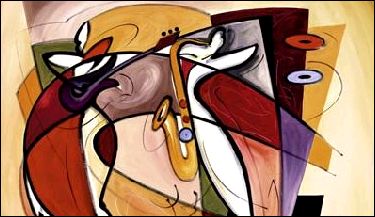Elements of Language and Literature: Concrete and Abstract Language
INTERPRETATION: Seeing the ABSTRACT in the CONCRETE
NEXT: Lesson 2 Language Study: Concrete and Abstract Language in Romare Bearden's "The Return of the Prodigal Son"
INTERPRETATION: Seeing the ABSTRACT in the CONCRETE
|
| Before we talk a bit more about CONCRETE AND ABSTRACT LANGUAGE, let us take a quick look at CONCRETE AND ABSTRACT elements in ART as there are similarities in interpreting both. Take the picture above, for example. Most of us can identify a few CONCRETE objects, such as:
Colors, shapes, and lines are also apparent, but even so, the image as a whole does not provide an organized or unified scene. What the image does provide, however, is an IMPRESSION...
|
NEXT: Lesson 2 Language Study: Concrete and Abstract Language in Romare Bearden's "The Return of the Prodigal Son"

